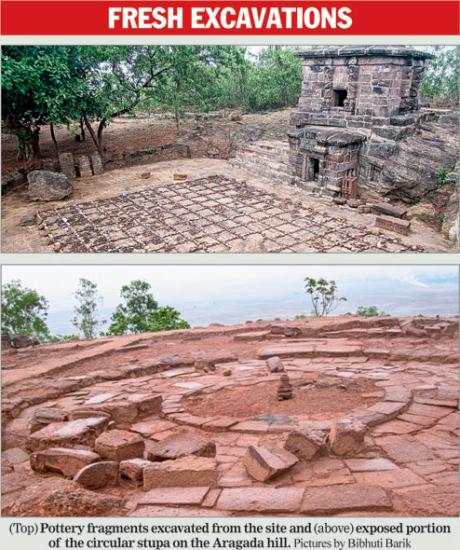New light on stupa ancestry
Bibhuti Barik
Source http://www.telegraphindia.com/1150613/jsp/frontpage/story_25460.jsp#.VXxted-c08o

 Archaeologists and researchers of the Odisha Institute of Maritime and South East Asian Studies have discovered that the circular stupa, which they excavated atop the Aragada hills, is contemporary of the Khandagiri and Udayagiri caves in the city.
Archaeologists and researchers of the Odisha Institute of Maritime and South East Asian Studies have discovered that the circular stupa, which they excavated atop the Aragada hills, is contemporary of the Khandagiri and Udayagiri caves in the city.
It is believed that most of the Khandagiri and Udayagiri caves were carved out as residential blocks for the Jain monks during the reign of King Kharavela.
The experts have come to the conclusion after studying the artefacts and types of architecture associated with the stupa, which is a mound-like structure containing Buddhist relics, typically the ashes of monks, and used by the Buddhists as a place of meditation.
The institute's secretary and excavation team leader Sunil Patnaik said: "Earlier, during the preliminary stage, we thought that the structure would date back to 7th or 8th century. But, after comparative analysis and consultations with other archaeologists, we are of the opinion that the stupa belongs to 1st or 2nd century BC."
Patnaik said the Buddhist sites such as Lalitgiri and Langudi could also be contemporary to the Aragada site.
Among the new things that have appeared now since the April last week findings are the remains of a monastery and associated structures on the left of the circular stupa, an inscription of a later age (around 8th century) and a cave, probably used by the Buddhist monks to meditate towards the opposite side of the excavation site on the hill, are the prominent ones.
Patnaik said from the collection of pottery, many untold facts of history had come out, and by studying them, they had now come to know of the structure's age. The pottery collections (according to their site of collection or grids) are seen spread on the floor in front of the double-storey temple, which is there at Aragada.
An excavation site is divided into several grids for detailed work.
Earlier, the state archaeology had preserved the double-storey temple.
Regarding the discovery of the cave on the other side of the hill, local resident and conservation worker Pradip Bhoi said: "It is difficult to reach there from the stupa site. The deity, Banadurga, which was inside a temple just below the cave, is now worshipped near the foothill."
"The temple of the deity was there on way to the cave in the middle of the hill, but during the 1999 Super Cyclone, the temple was broken and the villagers had recovered the damaged idol from near the foothill. Since then, the deity has been worshipped there," he said.
Earlier, another local resident, Bhoi, had said: "Till 1984, the Aragada hill was unknown outside this area, and the villagers used to be the cave temple's caretakers. In 1984, during the Raja utsav, we had invited former MP Chintamani Panigrahi to the festival. After that, the place gradually came into notice with the culture department's involvement."On the inscription found from a slab-like rock from near the stupa, Patnaik said epigraphists would decipher the exact language, so that it could throw some light on the early and later stage of the monument on the hilltop.
The institute now plans to continue the excavation with the weather reports predicting less rains over the next few days.
"We will expose some more portion of the stupa and stabilise it by several conservation technologies without changing its original nature. Once the structure is stabilised, beautification process will start by landscaping around the structure," Patnaik said.
The culture department, of which the institute is a part, also wishes to include the developed Aragada stupa on the tourism map of the state's well-known Buddhist circuit.
"It can be clubbed with sites such as Dhauli in the local package," said an official.
Historians are also studying the correlation between the locations of Sisupalgarh, Dhauli hills, Biswanath hill and Aragada as they appear to form a cluster. They think that there might have been a sizeable Buddhist population in and around Bhubaneswar as the infamous Kalinga War (261 BC) was fought on the banks of the Daya river near the Dhauli hills.